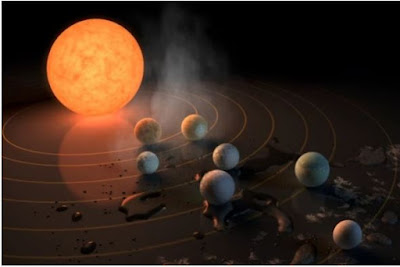For planet-hunting astronomers seeking twins or even cousins of Earth around other stars, the universe has just become much less lonely.
To qualify as close planetary kin, another world must be rocky and reside in the not-too-hot, not-too-cold “habitable zone” of its star, bathed in approximately as much starlight as Earth. There—if it possesses an atmosphere neither crushingly thick nor vanishingly thin—such a world could harbor a temperate climate where life-giving liquid water might pool in lakes, seas and oceans. Statistics from ongoing planet surveys suggest billions of worlds in our galaxy could meet these meager criteria, but so far less than a dozen candidates have been found that merit spine-tingling speculations about mirror Earths.
At least, that was the case until today. Writing in Nature, an international group of researchers details the discovery of seven worlds comparable with our own, orbiting a star 40 light-years away in the constellation Aquarius called TRAPPIST-1. Three of the planets orbit in TRAPPIST-1’s habitable zone and the other four could also conceivably sustain liquid water and life under certain atmospheric conditions. All appear to be roughly the same size, mass and composition as Earth.
For now the planets of TRAPPIST-1 are known only by their catalogue notations—TRAPPIST-1 b, c, d, e, f, g and h, labeled in order of their distance from their star. Soon that may change—the worlds will cry out for names as astronomers revel in their study and come to know them. TRAPPIST-1 is so cosmically close to us, so rich with promising worlds, that it is destined to be a touchstone for all future searches for habitable planets. And within a decade, some optimists say, studies of TRAPPIST-1 could provide compelling evidence for the existence of life beyond our solar system.
Scientific American: Nearby Star Hosts 7 Earth-Size Planets [Video], Lee Billings

Comments